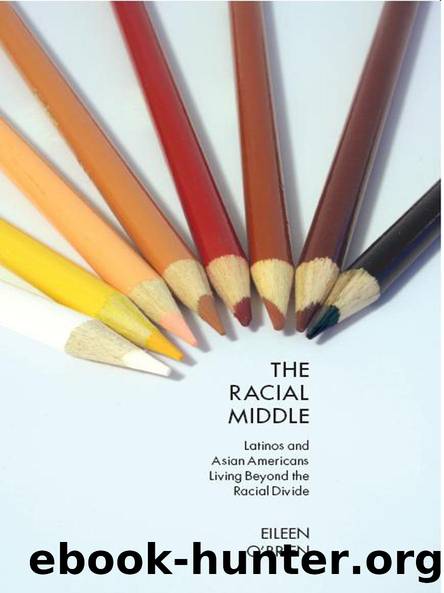The Racial Middle by Eileen O'Brien

Author:Eileen O'Brien [O'Brien, Eileen]
Language: eng
Format: epub
Tags: Social Science, Ethnic Studies, General, American, Asian American Studies, Hispanic American Studies
ISBN: 9780814762141
Google: 9A4UCgAAQBAJ
Publisher: NYU Press
Published: 2008-06-15T05:23:46+00:00
Asian American Variance on Everyday Ethnocentrism: Fending Off Degenerate American Values
Although those in the racial middle have much in common regarding the messages they receive about interracial border crossing, there are some differences between Latinos and Asian Americans on these matters. A distinctly Asian American dynamic was the actual discouragement of marrying whites. No Latinos actually expressed disapproval of whites wholesale. This Asian American ethnocentrism was connected to a specific rejection of certain American cultural values, so it did not merely single out whitesâit was really directed at any non-Asian, whites included. Parents who seemed resistant to out-marriage to whites cited certain cultural values, such as respect for elders and high emphasis placed on education, that they feared their children would lose through their process of becoming âmore American.â These fears seemed to go a step beyond those who simply wanted to retain language and certain celebrations, customs, and foods. They contained an element of cultural superiority and a fear that their children would be infected with a more disrespectful posture.
As discussed in chapter 2, there exists a distinct, additional hierarchy in the minds of some Asian Americans about the superiority of certain Asian nations over others. The history of Japanâs colonization of other nations renders them somewhat of an Eastern superpowerârespected, feared, and resented for what is sometimes perceived as its sense of entitlement over others. Although China seems to rank a bit lower than Japan, due to its history of communism and isolation from Western cultural influences for some time, both Chinese and Japanese Americans have dominated the pan-Asian movement in the United States, having the longest histories of migration and largest Asian American populations up until the 1960s. There has been some resentment expressed historically by members of other Asian ethnic groupsâsuch as Filipinos, Koreans, and Vietnameseâthat the Chinese and Japanese have taken precedence over other groups in pan-Asian organizations.12 Further, some tension exists between South Asians and the rest of the Asian panethnic category, particularly due to the British influence over India (which has spilled over into Pakistan and Bangladesh to some extent) and the greater significance of religious culture (Hindu and Muslim) in that region than in the Far East. Indians were not even included in the censusâs Asian racial category until 1980, and in the earlier part of the century they had sometimes enjoyed a status similar to whites.13 Thus, these divergent experiences have led to definite notions of superiority and inferiority between and among various Asian ethnicities, which were sometimes expressed in respondentsâ discussions of the most and least preferable mates.
This preference for oneâs own ethnicity is often even more limited than just someone from the same country. Several Asian cultures observe rigid designations within their own particular nation as well. For instance, Paul Spickardâs work outlines a distinct hierarchy among the Japanese, where whites are preferred before blacks and Latinos, but also Japanese from oneâs own village or immediate surroundings are preferred before the Okinawans or the etaâin fact, for the Issei
Download
This site does not store any files on its server. We only index and link to content provided by other sites. Please contact the content providers to delete copyright contents if any and email us, we'll remove relevant links or contents immediately.
| Anthropology | Archaeology |
| Philosophy | Politics & Government |
| Social Sciences | Sociology |
| Women's Studies |
Born to Run: by Christopher McDougall(7028)
The Leavers by Lisa Ko(6876)
iGen by Jean M. Twenge(5326)
Sapiens by Yuval Noah Harari(5264)
The Kite Runner by Khaled Hosseini(5038)
Spare by Prince Harry The Duke of Sussex(4996)
Bullshit Jobs by David Graeber(3993)
Machine Learning at Scale with H2O by Gregory Keys | David Whiting(3969)
Never by Ken Follett(3703)
Goodbye Paradise(3666)
Livewired by David Eagleman(3623)
Fairy Tale by Stephen King(3156)
Harry Potter 4 - Harry Potter and The Goblet of Fire by J.K.Rowling(2942)
A Dictionary of Sociology by Unknown(2924)
The Social Psychology of Inequality by Unknown(2900)
The Club by A.L. Brooks(2812)
Will by Will Smith(2735)
0041152001443424520 .pdf by Unknown(2727)
People of the Earth: An Introduction to World Prehistory by Dr. Brian Fagan & Nadia Durrani(2673)
